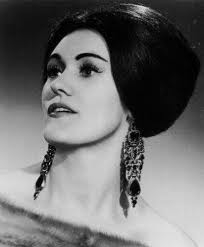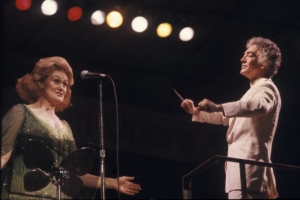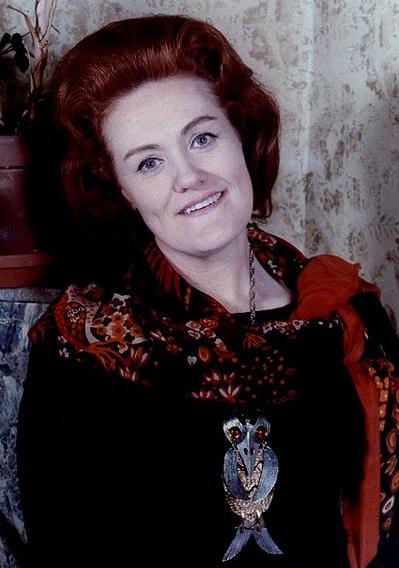Joan Sutherland’s was the voice of my childhood, the voice on the record-player when my mother, a coloratura soprano, practised her Lucia and Traviata. It was a clear and ravishingly carefree sound, as fluid as a stream bubbling in sunlight, effortlessly scintillating in the highest registers, a voice that almost sounded regretful as it descended to earth.
I drank in her bel canto records (I too wanted to be a singer), and generations of trainee sopranos sped through their two-octave scales seeking that sweetness, that blitheness, and also that plummy lushness. Not for the teenaged me the canaries like Beverly Sills over in America, or even the golden Verdians like Renata Tebaldi. Sutherland’s Lucia seized my romantic imagination, fearful by the well, with a sense that as her voice climbed and climbed, so did her character, running away from the ghosts.
Her Mad Scene had an escapist quality that I don’t remember anyone else equalling for me - the way she chased the flute into the stratosphere, as if by cutting the bonds of sanity she could fly away into the sky. It was a few years before I started to realise that there were other sopranos whom suddenly I would feel in my guts, in painful spasms, women with more imperfect instruments - Ileana Cotrubas, Maria Callas (who was absent from our record collection). And I fell suddenly out of love with Sutherland and her mangled vowels, her beauty of tone and her unwavering agility and ease.
In my teens I had read a biography of her, about the miracle that occurred when her husband Richard Bonynge, a piano student a little younger than herself, noticed that when she was around the house doing the washing up she sang in a high, unforced soprano register that was markedly different from the rich mezzo-tinged voice she used in her day job at Covent Garden as a "utility soprano" when she arrived there in 1951. Her mother had been a mezzo, and Joan - an ungainly six-footer with a jaw like a mantelpiece - evidently never saw herself as romantic heroine soprano material. Breastplates and Wagner were probably her best niche, she felt, rather than competing with more petite, prettier sopranos for Mimi or Cio-Cio San, and she weighted her sound accordingly.
Bonynge tricked her into stretching and lightening her voice upwards, by pretending to her she was in a lower key than she was - suddenly out were coming top Cs, top Ds, top Es. But it was Callas’s time, and that of other assured Italian divas who wore Fifties fashions with élan. The modest, gawky Sutherland was, at over 30, still not a sure bet for the big time at Covent Garden.
Here is Sutherland in 1958, in a recording of a Rossini song which shows the exceptional limpidity of her voice then, without a hint of mezzo tone or Wagnerian heft, and with that virtuosic facility already firmly prepared by Bonynge. Yet it seems a very young 31-year-old that one is hearing, with a lack of belief in herself as a leading lady:
 Sutherland sings Rossini's "La Fyoraia Fiorentina" in June 1958 (an uncredited accompanist) - from Maria Callas & Joan Sutherland: The Art of the Coloratura (Everest)
Sutherland sings Rossini's "La Fyoraia Fiorentina" in June 1958 (an uncredited accompanist) - from Maria Callas & Joan Sutherland: The Art of the Coloratura (Everest)
Bonynge fought hard to get her the break he was certain she deserved, that historic Lucia di Lammermoor in 1959, in which - soaked gorily in blood in Franco Zeffirelli’s gothic production - she raised the roof and became a world star overnight. She then went straight off to hospital to have her sinuses scraped, various vocal and dental operations, any of which could have destroyed her voice - but Joanie was not a precious type. She refused to get stewed up about it and got back to work.
Below, Sutherland's Mad Scene from a Lucia transmission in 1960 (coloraturafan on YouTube):
After Lucia, her career’s global progression was masterminded by the possessive Bonynge, beating a then unfashionable path to the bel canto canary-bird roles of droopy girls going mad, or baroque goddesses trilling impossible vocal curlicues. Sutherland’s death yesterday brought out passionate critics of Bonynge’s Svengali tactics, people who blamed the husband for preventing Sutherland from becoming Covent Garden’s mighty über-soprano in the Sixties, London’s answer to Callas and Nilsson, rather than a jetsetting world star sticking to safe, high-earning dates. But Sutherland adored her husband, grateful to him for making her a wife and a mother as well as a diva dubbed “La Stupenda”. None of this would she have expected in the least for herself, let alone the statuesque polish in her grooming that while it could never rival the dramatic Callas beauty made her feel less of a big country mare from Australia.
 The split between the supporters of Sutherland and Callas was not just a temperamental choice between a placid, earthy, embroidery-loving wife and a nervy, emotional, glamorous opera queen. It was also about two differing approaches in operatic soprano delivery - the creamy technical gorgeousness of the one against the irresistible, deliberately variable soul of the other. Today’s sopranos have drawn fruitfully on both, but though there have been astonishing coloraturas around (Edita Gruberova, Cecilia Bartoli and Natalie Dessay, for example) who took on famous Sutherland rep, the Rolls-Royce richness that came out of that lantern jaw, the purring reliability of the engine behind that cavernous resonance chamber, was a sound that one can’t imagine in bel canto or Handel today with smaller orchestras of semi-skimmed instruments. Yet the popularity of this rep today surely owes a seminal debt to Sutherland and Bonynge.
The split between the supporters of Sutherland and Callas was not just a temperamental choice between a placid, earthy, embroidery-loving wife and a nervy, emotional, glamorous opera queen. It was also about two differing approaches in operatic soprano delivery - the creamy technical gorgeousness of the one against the irresistible, deliberately variable soul of the other. Today’s sopranos have drawn fruitfully on both, but though there have been astonishing coloraturas around (Edita Gruberova, Cecilia Bartoli and Natalie Dessay, for example) who took on famous Sutherland rep, the Rolls-Royce richness that came out of that lantern jaw, the purring reliability of the engine behind that cavernous resonance chamber, was a sound that one can’t imagine in bel canto or Handel today with smaller orchestras of semi-skimmed instruments. Yet the popularity of this rep today surely owes a seminal debt to Sutherland and Bonynge.
The voice showed wear in the nether regions much more quickly than upstairs, Sutherland’s unclear diction deteriorating as she pulled more and more “cover” over her sound, and hooting mannerisms crept in. She was not a particularly good musician, I remember realising once I’d stopped being dazzled - but she was a stupendously surefooted singer. Some artists (Elisabeth Schwarzkopf and Callas being two) work ceaselessly at improving what they perceive as defective voices, yet it’s these cracks in the material’s surface that are where their expressiveness lies. Sutherland possessed such a phenomenal natural gift that she was understandably consumed with polishing and buffing it to flawless, all-purpose, legato glory. I rapidly lost interest in her.
 Yet when she did her last Lucia in London in 1985 I couldn’t resist going. I remember being open-mouthed at the variance between the age of her face and a voice that could still (just) catch the thermals. And then she stomped out in front of the curtain with a smile the size of the grand circle, self-deprecating about the absurdity of a gigantic galumphing 60-year-old pretending to be a romantic teenage waif. You need a sense of fantasy, a belief in your own transformability, to inhabit the properly tragic operatic roles of Verdi, Tchaikovsky or Berlioz, and my impression from meeting Sutherland a while ago (after her career ended) was that she felt extremely comfortable with what she had achieved, and eternally grateful for it. Like Pavarotti, one of her favourite stage partners, she enjoyed sounding effortless, and did not fancy straining too near to the limits of her preferences. (Bonynge and Sutherland pictured right in Australia, National Library of Australia.)
Yet when she did her last Lucia in London in 1985 I couldn’t resist going. I remember being open-mouthed at the variance between the age of her face and a voice that could still (just) catch the thermals. And then she stomped out in front of the curtain with a smile the size of the grand circle, self-deprecating about the absurdity of a gigantic galumphing 60-year-old pretending to be a romantic teenage waif. You need a sense of fantasy, a belief in your own transformability, to inhabit the properly tragic operatic roles of Verdi, Tchaikovsky or Berlioz, and my impression from meeting Sutherland a while ago (after her career ended) was that she felt extremely comfortable with what she had achieved, and eternally grateful for it. Like Pavarotti, one of her favourite stage partners, she enjoyed sounding effortless, and did not fancy straining too near to the limits of her preferences. (Bonynge and Sutherland pictured right in Australia, National Library of Australia.)
Her Turandot excerpt here, dating from 1972, shows the Sutherland late prime, the exultant invulnerability of her voice at the top, its middle tone darkening towards her mezzo genes, and a stately nobility in her delivery that unwittingly conveyed a wistfulness very different indeed from her great rivals in the role, Callas and Birgit Nilsson. It was a role she was only willing to record, not to do on stage. Young Pavarotti is a thrilling Calaf, but Sutherland sweeps him before her with those magnificent, unwavering high notes that never sound desperate, but like a ship under full splendid sail. She still slays me with the seraphic firmness of her extraordinary top register. Where there are trumpets, there will be Sutherland.
 Sutherland sings Turandot's "C'era negli occhi tuoi" with Pavarotti in 1972 - Zubin Mehta conducts the LPO (Decca) (find this recording on Amazon)
Sutherland sings Turandot's "C'era negli occhi tuoi" with Pavarotti in 1972 - Zubin Mehta conducts the LPO (Decca) (find this recording on Amazon)
David Nice writes:
For me, too, at least from the ages of 10 to 16, Joan Sutherland was opera. It all started with a visit to the local record library: my mother had seen a film featuring the Bell Song from Delibes’s Lakme (it would have been sung either by Kathryn Grayson in It Happened in Brooklyn or Lily Pons in I Dream Too Much, she never could remember which). And there it was on a Decca LP called The World of Joan Sutherland – an approved if unheard name at home.
I was hooked, fascinated by the woman with the big hair on the cover but also by her versatility (the compilation also included the Nuns’ Chorus from Johann Strauss II’s Casanova, a bit of Coward with the voice of Noël himself and a track that made me especially jolly – Leoncavallo’s "La Mattinata"). Of course the agility was what our family ooh-ed and aah-ed about, but I don’t think we realised quite how rare it was that Sutherland took her brilliance right up there to a firm and full top instead of flipping into head voice like nearly all coloraturas before her.
It served her in exceptional stead for the recorded Turandot (mentioned above) – rock-solid and brilliant, never bettered for sheer beauty of heroic sound and by no means overshadowed by Caballé’s Liu on the same set – as well as in a role she later apparently said she remained proudest of, Massenet’s Esclarmonde, written for the three-octave range of American soprano Sybil Sanderson. My God, how I loved that set, no doubt thrilling to the Wagnerian pretensions of Massenet’s orchestral writing (once past her apprenticeship, Joanie only ventured into Wagner once on an excerpts disc, one of her least exciting adventures). But I still think the incantation "Esprits de l’air" shows Sutherland at her heroic, fearless best.
I wrote to her Swiss home of Les Avants, and received a card with a drawing of Joan and Richard in Dickensian costume, in which she thanked me for my kind words about Esclarmonde and added, "I don’t think Covent Garden is very keen on doing the piece." (They eventually did it, she wasn’t at her best and, ensconced at university up in Edinburgh, I didn’t make the effort to go and see it.) The letter is lost, along with a signed portrait of her as Lucia in 1958. No matter: I met my idol outside the stage door of the Albery Theatre, where she and "Ricky" were spending an evening’s anecdotalising with Alan Sievewright. She was as charmingly self-deprecating offstage as on, carrying a box of eggs and much amused by two "ghaaastly" T-shirts, tinsel on green, proclaiming "Joan IS Maria Stuarda" (one of the wearers became my boss when I worked part-time in the Music Discount Centre, and sang in the same amateur opera group as I did. He does, or did, a magnificent lip-synch to Sutherland recordings).
At the same time I finally saw my idol in action – the Mary Stuart in question was Donizetti’s. As a junior friend of the Royal Opera, I went twice – to a dress rehearsal, and a performance – and I think I was already becoming suspicious of the rep: why was there so little memorable music in the piece other than the conflict with Queen Elizabeth where she calls Gloriana a "vile bastard" and the lovely prayer before she goes to her death?
The bel canto repertoire in which Bonynge nurtured her so tirelessly – and thanklessly, it would seem, in the eyes of critical posterity – was already for the chop in my mind. At around the same time, I discovered Hildegard Behrens in Salome, which excited me more. Strauss and Wagner pushed Bellini and Donizetti out of the way. So a new cause dawned: Joan for Empress in the promised Solti recording of Strauss’s Die Frau ohne Schatten. Didn’t happen, and she no doubt had a longer career sticking to Lucia and Norma (shame: her second recording of Bellini’s not-so-vestal-virgin reveals that the coloratura had become more effortful, but the recitatives are thrilling).
I saw her once more, as Anna Bolena, in an absurd mannequin-parade production as kitschy as the pictures that adorned the walls of Les Avants. But by then, with what I regarded as more sophisticated tastes, I still marvelled at the awesome presence she conjured for the tragic queen’s last tour de force. She wasn’t a natural actress, but she had star quality as a person as well as a voice.















Add comment